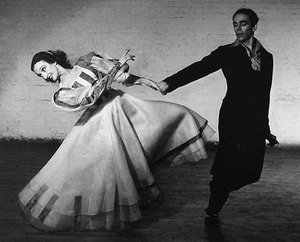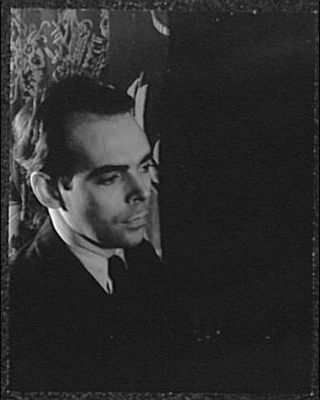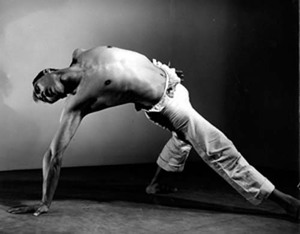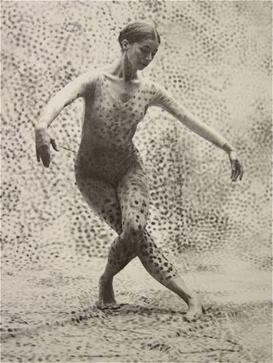
Modern dance in the United States is a form of contemporary dance that was developed in the United States in the 20th century. African American modern dance also developed a distinct style.

Doris Batcheller Humphrey was an American dancer and choreographer of the early twentieth century. Along with her contemporaries Martha Graham and Katherine Dunham, Humphrey was one of the second generation modern dance pioneers who followed their forerunners – including Isadora Duncan, Ruth St. Denis, and Ted Shawn – in exploring the use of breath and developing techniques still taught today. As many of her works were annotated, Humphrey continues to be taught, studied and performed.

Charles Weidman was a renowned choreographer, modern dancer and teacher. He is well known as one of the pioneers of modern dance in America. He wanted to break free from the traditional movements of dance forms popular at the time to create a uniquely American style of movement. Born in 1901, he choreographed from the 1920s until his death in 1975. While he is most famous for his work with Doris Humphrey, Weidman did much work on his own. He created a bridge to a new range of movement that he only began to explore. His work inspired many and helped to create a whole genre of dance that is still evolving today.
Louis Horst was a composer, and pianist. He helped to define the principles of modern dance choreographic technique, most notably the matching of choreography to pre-existing musical structure and the use of contemporary music for dance scores.

James Mitchell was an American actor and dancer. Although he is best known to television audiences as Palmer Cortlandt on the soap opera All My Children (1979–2010), theatre and dance historians remember him as one of Agnes de Mille's leading dancers. Mitchell's skill at combining dance and acting was considered something of a novelty; in 1959, the critic Olga Maynard singled him out as "an important example of the new dancer-actor-singer in American ballet", pointing to his interpretive abilities and "masculine" technique.

General Hershy Bar was a satirical character of the Vietnam War-era Anti-War protest movement, portrayed by William "Bill" Matons, in a parody of U.S. General Lewis B. Hershey, then Director of the Selective Service.

Geoffrey Lamont Holder was a Trinidadian-American actor, dancer, musician, and artist. He was a principal dancer for the Metropolitan Opera Ballet before his film career began in 1957 with an appearance in Carib Gold. In 1973, he played the villainous Baron Samedi in the Bond film Live and Let Die. He also carried out advertising work as the pitchman for 7 Up.

José Arcadio Limón was a dancer and choreographer from Mexico and who developed what is now known as 'Limón technique'. In the 1940s, he founded the José Limón Dance Company, and in 1968 he created the José Limón Foundation to carry on his work.
Jerome Weidman was an American playwright and novelist. He collaborated with George Abbott on the book for the musical Fiorello! with music by Jerry Bock, and lyrics by Sheldon Harnick. All received the 1960 Pulitzer Prize for Drama for the work.
Susan Weil is an American artist best known for her experimental three-dimensional paintings, which combine figurative illustration with explorations of movement and space.

Eleanor Campbell King (1906–1991) was an American modern dancer, choreographer, and educator. She was a member of the original Humphrey-Weidman company, where she was a principal dancer in the pioneering modern dance movement in New York City, then moving on to choreography and founding her own dance company in Seattle, Washington. She was a professor emerita at the University of Arkansas, where she taught from 1952 to 1971, before retiring to Santa Fe, New Mexico, to start a new course of study into classical Japanese and Korean dance. She choreographed over 120 dance works, and wrote extensively for a variety of dance publications. In 1948, she was named Woman of the Year in Seattle, and in 1986 was listed as a "Santa Fe Living Treasure", also receiving the New Mexico Governor's Artist Award. In 2000, her archive was recognized by the White House Millennium Council's "Save America's Treasures" program.

Modern dance is a broad genre of western concert or theatrical dance which included dance styles such as ballet, folk, ethnic, religious, and social dancing; and primarily arose out of Europe and the United States in the late 19th and early 20th centuries. It was considered to have been developed as a rejection of, or rebellion against, classical ballet, and also a way to express social concerns like socioeconomic and cultural factors.

Viola Farber was an American choreographer and dancer.
Helen Anne Molesworth is an American curator of contemporary art based in Los Angeles. From 2014 to 2018, she was the Chief Curator at The Museum of Contemporary Art (MOCA) in Los Angeles.
Pam Tanowitz is an American dancer, choreographer, professor, and founder of the company, Pam Tanowitz Dance. She is a current staff member at Rutgers University's Mason Gross School of the Arts where she teaches dance and choreography. Her work has been performed at notable performance venues such as the Joyce Theater, the Joyce SoHo, and New York Live Arts, Kennedy Center for the Performing Arts.

Elizabeth Schmitt Jennerjahn was an American artist and dancer. She was best known for her work as a dancer and dance instructor at Black Mountain College and later for her textile work and paintings.
David Weinrib (1924–2016) was an American artist most renowned for sculpture and ceramic art.

Pola Nirenska, born Pola Nirensztajn, was a Polish performer of modern dance. She had a critically acclaimed if brief career in Austria, Germany, Italy, and Poland in the 1930s before fleeing the continent in 1935 due to rising antisemitism. She spent 14 years in the United Kingdom, primarily entertaining refugees, troops, and war workers. She emigrated to the United States in 1949 and settled in Washington, D.C., where she was widely acknowledged as the city's leading choreographer and performer of modern dance until her death.
Miriam Pandor was a German dancer, director, choreographer, teacher and writer. She is well-known for her works which address racism, antisemitism and social injustice.
Marianne Preger-Simon is an American dancer, choreographer, writer, and psychotherapist. She is best known for her work as a founding member of the Merce Cunningham Dance Company.












